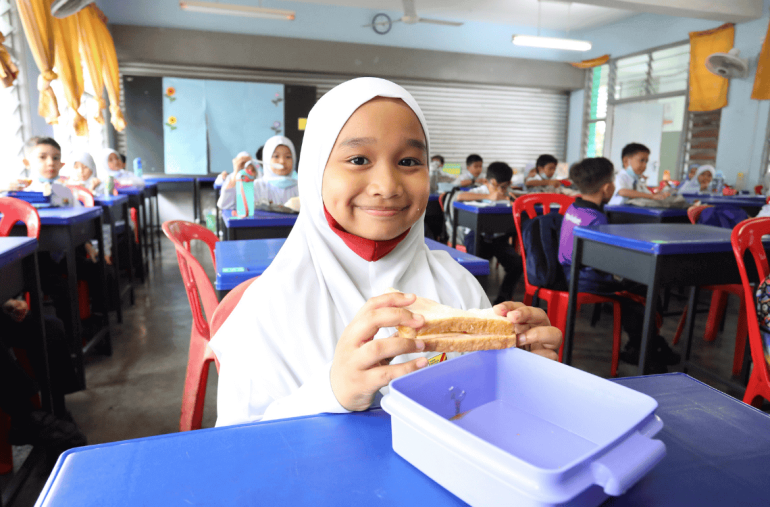High school ended about fifteen years ago for me, and honestly, the only thing I remember clearly is that school shoes used to be white (well, more like grey by the end of the year).
So, for parents like me who suddenly realise their almost-seven-year-old is about to enter big boy or girl school and need a serious refresher course, this one’s for you.
P/S: School shoes are now black. Socks too. Especially if your child’s going to a Sekolah Kebangsaan.
But beyond uniforms and stationery shopping, this transition is a big deal for both kids and parents.
Here’s everything I’ve learnt (and am still learning) as we prepare to send our little one off to Year 1.
Get the Basics Sorted Early
Before anything else, double-check your child’s school registration.
Some schools still require physical submission of documents, and if you haven’t done that, please do – most won’t add you to the parents’ WhatsApp group until you have.
And that group is where you’ll find out everything: orientation day, book list, class schedule, and even what colour hair accessories are allowed.
While you’re sorting out the paperwork, check your child’s vaccination records too.
Most schools require proof that your child’s immunisations are up to date, so make sure you have their records on hand.
If they’ve missed a dose, book a quick visit to your nearest clinic to catch up.
It’s also a good time to talk to your doctor about any optional vaccines that might benefit your child before school starts.
Staying vaccinated means staying protected – not just for your child, but for their classmates too.
Once that’s settled, it’s time for the essentials:
-
Uniforms: Try them on early to check fit (kids seem to grow overnight).
-
Shoes and Socks: Black is the new white, and buy two pairs if you can.
-
Name Tags: Order those little stickers with your child’s name, or just use a permanent marker. Label everything: water bottles, lunch boxes, pencils, erasers, even shoes. They WILL go missing.
-
Books and Stationery: Keep an eye out for bookshop or stationery sales to stock up. Trust me, pencils and erasers have a mysterious way of disappearing by midweek.
For school bags, check if the school provides a place for students to store their books.
If they do, wrap your child’s books neatly and label them clearly.
Choose an ergonomic school bag that suits their height and frame, as seven-year-olds are still little, and carrying a heavy load up and down stairs daily can strain their backs.
Books and stationery will get misplaced. Discuss with the teacher about what usually happens if things go missing, whether replacements are needed immediately or if there’s a lost-and-found system.
Health, Medication, and Allergy Preparation
Every child is different, and some may need extra attention when it comes to their health.
If your child requires specific medication – such as for asthma, eczema, or other ongoing conditions – schedule a quick meeting with their class teacher before school starts.
Go through the medication routine, note what symptoms to watch for, and make sure the teacher knows where to find the medication if needed.
Label all medicines clearly with your child’s name and dosage instructions.
You can also keep a copy of the instructions in your child’s schoolbag or at the school office, just in case of an emergency.
For children with food allergies, take time to talk about what foods they can and cannot eat.
Help them understand how to avoid sharing snacks or buying risky foods from the canteen.
It’s a good idea to pack allergy-safe snacks or lunches from home; think mini sandwiches, muffins, or fruit cups so they always have something safe and fun to enjoy.
A few days before school begins, you can also check with the teacher if there’s an allergy protocol or plan in place.
Build a Routine That Matches the School Schedule
If your child has been waking up at 9 a.m. and strolling into playschool fashionably late, now’s the time to adjust.
Start easing into a proper school-day rhythm – wake-up, breakfast, brushing teeth, and bedtime.
We have a favourite hack: a quick breakfast in the car.
Not the best, I know, but sometimes, you just do what you have to do.
Simple options like egg sandwiches, banana pancakes, or French toast work perfectly for those rushed mornings.
This helps them (and you) get used to early mornings before the real chaos begins.
It also teaches them structure, which makes the first week of school far less overwhelming.
You can even do a mini “mock school week” in December – wake up, get dressed, have breakfast, and do short reading or colouring sessions during “study time”.
Introduce Reading and Writing Gently
Some children start Year 1 already reading simple sentences, while others are still figuring out letter sounds, and both are completely fine.
You can help by:
-
Reading short storybooks together every night.
-
Encouraging them to ask questions and sound out new words.
-
Practising basic writing like their name, numbers, and simple words.
-
Introducing fun worksheets or tracing books a few times a week.
The goal is not perfection but to make learning familiar and enjoyable. Consistency helps build confidence.
Teach Basic Independence
At school, your child will have to handle little tasks on their own.
Help them practise these skills at home so they’re not overwhelmed on their first week.
Start with:
-
Packing and unpacking their own school bag.
-
Using the toilet properly and washing hands well.
-
Managing lunchboxes, such as opening and closing containers and eating independently.
-
Asking for help when needed.
Side note: School toilets are not always the cleanest. Manage your child’s expectations early.
Teach them how to avoid sitting on wet seats, to use tissues, and to always wash their hands properly.
These little lessons make a big difference in helping your child feel secure and capable.
Talk About Personal Safety
This is an important one. Start teaching your child what’s okay and what’s not when it comes to personal boundaries.
Use simple, age-appropriate language to explain that some parts of their body are private, and no one should touch or ask to see them.
Reassure them that if anything ever makes them uncomfortable from another child or an adult, they can always tell you or a teacher right away.
There are many great books and videos that help make this conversation easier and less awkward for both of you.
Prepare for Big Feelings
Starting school is exciting, but it’s also emotional.
Your child may feel nervous, shy, or even scared, and that’s completely normal.
Expect a few (or a lot of) tears, clinginess, or even ‘tummy aches’ during the first week. Plan ahead for those emotional mornings.
Keep drop-offs short, reassure them that you’ll be back, and trust that they’ll adjust in time.
And for parents? It’s okay to feel all the feelings too.
Watching your little one walk into Standard 1 for the first time can hit hard.
You’ll be proud, anxious, and maybe a little heartbroken all at once – parenting is confusing at the very least.
Last but not least, keep the noise out and remind yourself there’s no such thing as a “perfectly prepared” parent.
Things will go wrong, but what matters most is being present, patient, and flexible.
You’ll soon find your rhythm, and your child will too. From your favourite parenting partner, all the best, parents!
Disclaimer: The information provided in this article is for informational purposes only and should not be considered as medical advice from Motherhood. For any health-related concerns, it is advisable to consult with a qualified healthcare professional or medical practitioner.
For more insightful stories and fun recipes, stay tuned to Motherhood Story!













